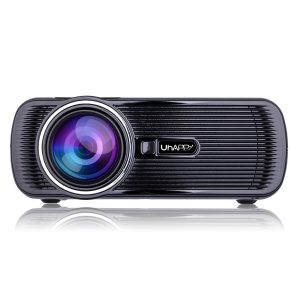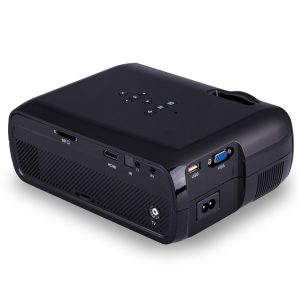Question: How to determine the width of the fusion zone for projection fusion?
Answer: For projection fusion, the projection images of adjacent projectors need to be partially overlapped, and the width of the overlapped portion should not be less than 20% of the projection width of a single projector.
Q: How to choose the cable used for projection fusion?
Answer: It is recommended to use digital signal transmission. VGA cable transmission is susceptible to interference from external factors. When the transmission distance exceeds 15 meters, it is recommended to use twisted pair or optical fiber transmission.
Q: What is the difference between the soft fusion and the hard fusion of the projector?
Answer: Soft Fusion is a kind of fusion software running on a computer, while Hard Fusion is a pure hardware architecture. Compared with the effect, the Hard Fusion is better and the stability is also strong. It can realize the functions of Picture-in-Picture and Roaming.
Question: What is the role of the fusion device?
Answer: Take two projectors as an example. The function of the blender is to reduce the brightness of the superimposed part of the two projectors by half, and then do the feathering treatment. To achieve the purpose of integration.
Question: What is the problem with the different grids when two projections of the same model are merged?
Answer: First, adjust the projection area and size of the two projectors to the same size, and then use the AGT-TS fusion debugging software to make detailed adjustments to make the grids of the fusion zone completely coincide.
Question: What methods can be used on the control end of the edge blender?
Answer: Edge fusion control end The control end of the edge fusion device can adopt a computer, a console or a central centralized control system
Question: How to ensure that the full-screen image is not deformed after projection fusion?
Answer: There is only one way: make a picture with the same ratio as the merged physical resolution.
Q: How much does the projection fusion cost?
Answer: How much money depends on how many projector fusion you build, whether you use hardware fusion or software fusion, and what type of projector you choose
Q: What is soft fusion?
Answer 1: Software fusion refers to the processing and fusion of the images projected by two or more projectors through the fusion software and the computer to show the effect of one projector.
Answer 2: Software fusion refers to the use of fusion software and a computer to process and merge the images of two or more projectors to display the effect of one projector image.
Question: How to choose the projector in edge blending?
Answer: When choosing a projector, we must pay attention to the brightness, resolution and uniformity of the projector. The more common projector products are CRT, LCD, DLP, LCOS, etc.
Q: What are the screen selection criteria for edge blending?
Answer: The screen selection must pay attention to the screen material, screen gain and semi-gain perspective, uniformity, smoothness, resolution, contrast, super seamlessness, etc.
Q: How do the two projectors blend together?
Answer: The first projection of the two projectors on the screen is basically the same size. The middle part overlaps, and the fusion zone can be eliminated after fusion.
Q: What are the three main products of the marginal convergence market?
Answer: There are three types of software integration: software and hardware integration, and pure hardware integration.
Q: What is the quotation for projection fusion?
Answer: Projection fusion is mainly to correct multiple projected images into a complete image. The reference price is 3500~4500 yuan/channel.
Q: Will the purchased fusion software expire?
Answer: It will not expire.
Q: What equipment do you need for projection fusion?
Answer: Hardware: signal source, VGA/RGB/AV series matrix, graphics fusion processor, control center, projector, projection screen touch control center; software: fusion software
Q: What is seamless arc curtain fusion?
Answer: The display screen is curved, and the image is corrected with a non-linear vector. Hide the overlapping part of adjacent channels, make the brightness and contrast of the screen consistent with the brightness and contrast of adjacent channels, so that the entire screen is fully integrated to meet the requirements of seamless display.
Question: Why can’t we choose a liquid crystal projector (LCD projector) for projection fusion?
Answer: Because the LCD projector will show chromatic aberration after a period of time and destroy the integrity of the screen.
Q: What are the benefits of projection fusion?
Answer: If 25% of the pixels are fused, a 4000×1200 resolution image can be generated by subtracting redundant overlapping pixels.
Q: What is the use of the image edge blending processor?
Answer: Realize the transition from independent screen presentation to multi-projection seamless widescreen presentation core equipment.
Q: How do we make the projection fully integrated?
Answer: The projection fusion technology can be used. The projection fusion technology is to overlap the edges of a group of pictures without blanks to display the entire picture, which is beautiful, larger and higher resolution. The effect of the picture is like the effect of a projector.
Q: What is the quotation for projection fusion?
Answer: 3000 to 4500 per channel. The price is mainly affected by its equipment, which is selected according to demand.
Q: Is there any company that can customize projection fusion software?
Answer: Liying Technology can customize projection fusion software
Q: What are the technical methods for edge fusion?
Answer: 1. The projector is aligned horizontally 2. The projector is aligned vertically 3. Multiple projectors are stacked.
Q: In addition to projection integration, what can your company do?
Answer: large-screen display, large-screen splicing, immersive stage, etc.
Q: What are the two types of fusion technologies?
Answer: 1. Hard fusion 2. Soft fusion
Q: What is the projection multi-channel fusion technology?
Answer: Multi-channel fusion refers to the fusion of two or more projected images on one screen. Fusion technology now has both soft and hard fusion. The price of soft fusion is relatively cheap, but the stability is poor. Hard fusion has good stability, but also pay attention to some brands, some small manufacturers also do hard fusion, but the performance and effect are not very good, it is recommended to find a better manufacturer.









